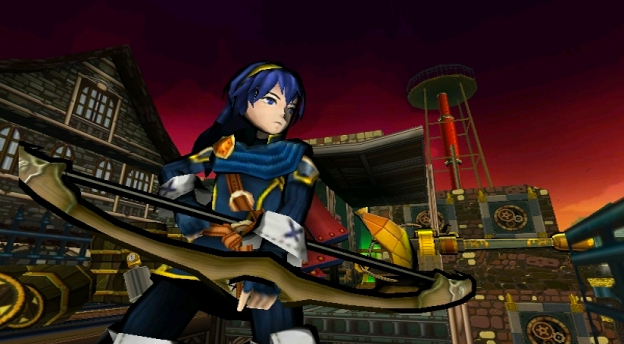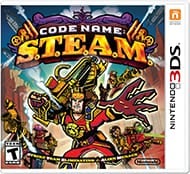Gimme S.T.E.A.M.
Abraham Lincoln faked his death to create a steampunk army of iconic, fictional characters to fight some really disturbing aliens and save the world with some of the most patriotic armor and equipment you’ve seen since BioShock Infinite . Does that sound interesting to you? Well, then you might be ready for some Code Name: S.T.E.A.M. Maybe.
Code Name: S.T.E.A.M. is a tactical RPG set in an alternate reality where everybody decided steam was pretty great. It seemed to work out for them, what with the airships, neat weapons, and all. That is, until the aliens arrived. They hit London hard, and even tried to abduct the Queen. Fortunately, Henry Fleming and John Henry were picked up by Abe Lincoln, who saw this whole thing coming. The duo are quickly recruited onto the S.T.E.A.M. team and sent off to fight some aliens all around England and America.
Keeping with its cel-shaded theme, Code Name: S.T.E.A.M. embraces the comic book motif. It meshes well with the outlandish premise, characters, and equipment peppered throughout the adventure. If something would make any sense at all, Code Name: S.T.E.A.M. doesn’t need it! A cast of fictional characters? Sure. Weird weapons that involve penguins and bananas? Load ’em up. A mecha suit for Abraham Lincoln that looks like Honest Abe? It has its place here.
Permit me to stop and discuss the Abe Mech. This is the worst element of Code Name: S.T.E.A.M. , as it feels so out of place. Every few episodes, one is suddenly there. It feels like an excuse to use Abe, just because Intelligent Systems thinks people would have wanted to use him. There are other means in which he could have been implemented as a playable character, better ones that wouldn’t involve a one to two minute flailing match against an alien that’s barely a challenge. Quick Time Events require more skill than these bouts and are often more challenging to boot.

It’s odd, because the other mechanics of Code Name: S.T.E.A.M. are so solid. Steam is used for movements and attacks, limiting progression and action on the field. Each character has a set main weapon and a fixed special skill that can be used once per each Campaign map. In addition, new sub weapons and steam tanks unlock as medals and gears are collected. These can be used to customize characters to your liking at the opening of each chapter. Different tanks have different storage and recharge ranks, while various weapons have different strengths, areas of attacks, and steam requirements. A few even heal.
Combat is a turn-based system on a grid, with sides taking turns for action and movement. In campaign mode, this leads to some of Code Name: S.T.E.A.M. ‘s more tedious elements. Enemies take a long time to move, because they’re moving in real time when it’s their turn. At the start of a match, I almost recommend having a mobile game pulled up on your phone to play between turns. It really does take that long. At least the maps often have a handful of one-time-use save poles on them. Those come in handy when it feels as though you’ve been playing forever and really need a break.

Once your turn begins, however, Code Name: S.T.E.A.M. can be a pleasure to play. The controls are tight, you can really see how each weapon has its own levels of accuracy and range, and the cover-based system works great when attempting to outwit opponents to catch their weak spots. I especially like how realistic it can be, as you do have to seek out the most strategic spots to find the best views of the battlefield. This realism is a nice contrast to the silly nature of many characters.
Especially wonderful is the overwatch system. The HUD shows how much steam power is needed for weapon attacks. Some weapons have the ability to go into overwatch. Should you leave enough steam unused when a turn ends, that character will then be ready to counter if a foe enters their line of sight during the enemy’s movement phase. Leave enough steam and the character will attack multiple times. It’s super effective and adds another layer of strategy to the game.
There were a few moments when Code Name: S.T.E.A.M. felt a bit cheap or unfair. One of my clearest memories of this is a bridge map where the team had to revive frozen civilians. There were six, and dang if that fifth one wasn’t hidden in the last place I’d think to look. The victim blended in pretty well with the alien’s ice, and it didn’t seem quite fair to squirrel it away the way one would expect a medal or gear to be. The plus side is that the action buttons and New 3DS XL circle nub really help to get a perfect view of the field. If this does happen, you can find a better vantage point.
There were also some times when it seemed like enemy reinforcements would be employed as a means of artificial difficulty. Getting close to a goal? Hey, some more aliens coincidentally appear. Fortunately, maps rely on objectives like “reach this spot,” “save these people,” or “beat that boss” so engagements are often optional. Still, optional doesn’t mean entirely unavoidable, and it can be easy to get drawn into longer engagements than intended.
It’s not a stretch to say that sometimes I found myself playing Code Name: S.T.E.A.M. so I could unlock more characters, steam packs, and weapons to use in the multiplayer. With the exception of the Abraham Lincoln mech battles, it’s easily the best element of the game. The diversity of the character roster allows for the implementation of many different strategic maneuvers. Especially since the Deathmatch and Medals options each require different approaches to guarantee success. You can’t have one team or plan and apply it everywhere. Success is earned.

Which isn’t to say the multiplayer elements are perfect. If you want to play with friends, you have to go with a Tournament series. Single rounds only have a random player option, which should prove quite irritating after launch. When I was savoring the Code Name: S.T.E.A.M. versus with an extraordinarily kind man I shnookered into playing with me, we were pressing the OK buttons simultaneously to ensure we were matched with each other. Even that probably won’t work once people are playing around the world.
Speaking of which, one of my first matches illustrates how well balanced Code Name: S.T.E.A.M. is when it comes to playing against real people. When we engaged in our first three matches, he had played far longer than I had. I’d only unlocked the first four characters and Marth (scanned in from his Amiibo). Our first two matches, Deathmatch and Medal Battle rounds in that order, went to him. However, the third match was mine. I even managed to best him without losing a single agent. It proved that even though he had access to characters I hadn’t seen yet, they weren’t gamebreakers. You can do as well with the initial four as you can with end-game characters.
I only wish the multiplayer allowed a person more time to determine a course of action. You get one minute before you turn ends. That’s 120 seconds to arrange four units on a map. It makes reconnaissance more difficult, and I found myself exercising far more caution than I would in other strategy games. Perhaps it’s something that will become more comfortable with time, as I intend to enjoy the versus element in the weeks, maybe even months, to come. Still, a little less constriction would have been appreciated.
All in all, it feels like Intelligent Systems isn’t quite sure of what kind of audience it wants Code Name: S.T.E.A.M. to find. My gut says this is for adults and strategy game veterans. It can be a rather challenging game, some of the characters have origins in advanced reading material, and the campaign clearly requires patience.
However, there are so many random and cartoonish elements that I can’t help but wonder if Code Name: S.T.E.A.M. is supposed to be “My First Strategy Game.” The Mecha Abe moments are clearly pandering to a more juvenile crowd in terms of both gameplay and premise. It also felt like it was attempting to encourage entertainment in disguise. “Hey! This is Tom Sawyer! Don’t you think he’s cool? Doesn’t this make you want to read The Adventures of Tom Sawyer ?”
Code Name: S.T.E.A.M. felt uneven to me. There’s a lot of promise here, and the jovial experience was inviting. I loved the multiplayer far more than I expected to and look forward to many more hours playing it. The problem is a campaign that feels like it takes far too long for things to really happen, especially when all aliens move in real time and you have to clear multiple maps before you get a real stopping point. I like the lore and world enough to hope that this isn’t the end for this series, and that instead Intelligent Systems will be given an opportunity to build on this foundation.
RATING OUT OF 5 RATING DESCRIPTION 4.0 Graphics
The cel-shaded characters and comic book presentation fit with Code Name: S.T.E.A.M.’s whimsical presentation. 5.0 Control
Switching between weapons is simple, the camera never works against you, and tugging the chain to trigger a special makes you feel powerful. 4.0 Music / Sound FX / Voice Acting
The soundtrack isn’t anything special, but a cast of fresh voice actors really makes the game stand out. 4.0 Play Value
The campaign feels longer than it needs to be, but Versus offers one of the best multiplayer experiences on the 3DS.. 4.3 Overall Rating – Great
Not an average. See Rating legend below for a final score breakdown.
| Review Rating Legend | |||
|---|---|---|---|
| 0.1 – 1.9 = Avoid | 2.5 – 2.9 = Average | 3.5 – 3.9 = Good | 4.5 – 4.9 = Must Buy |
| 2.0 – 2.4 = Poor | 3.0 – 3.4 = Fair | 4.0 – 4.4 = Great | 5.0 = The Best |
Game Features:
